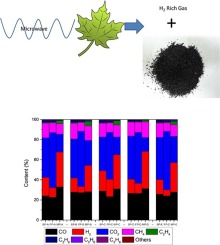Catalysis Today ( IF 5.2 ) Pub Date : 2018-02-24 , DOI: 10.1016/j.cattod.2018.02.048 Benzhen Yao , Tiancun Xiao , Xiangyu Jie , Sergio Gonzalez-Cortes , Peter P. Edwards

|
In order to obtain the most favorable pyrolysis process for producing the highest yield of syngas from a range of leaf plants, the techniques of slow pyrolysis, fast pyrolysis and microwave pyrolysis of apple tree leaves, bamboo leaves, cypress leaves, sycamore tree leaves, and winter green leaves were investigated. The results showed that microwave pyrolysis produced the highest gaseous product yields (hydrogen rich gas) on all the 5 different kinds of leaves The apple tree leaves, sycamore leaves and wintergreen leaves showed higher yields of gas products than bamboo leaves and cypress leaves across all forms of pyrolysis. The experimentally determined higher heating values (HHV) of bio-chars from different leaves ranged from 20 to 28 MJ/Kg, interestingly, which are comparable to some coals. For the same variety of leaves, the HHV of bio-chars via different pyrolysis processes did not change significantly. However, the HHV of bio-chars from different leaves behaved differently, with the bio-char from wintergreen leaves showing the highest HHV, which reached around 27 MJ/Kg; on the contrary, the HHV of bio-chars from bamboo leaves gave the lowest values, some 20–22 MJ/Kg. For the gaseous products, the total amount of H2, CO, CO2 and CH4 reached 95% from all 3 pyrolysis treatments. Importantly, compared with slow and fast pyrolysis, the microwave pyrolysis of different leaves shows the highest content of H2 and CO and the lowest contents of CO2. The HHV of gaseous products of different leaves, using the same pyrolysis treatment, showed similar values but noticeably different when the pyrolysis process is for the same leaves is changed. The HHV of gaseous products via microwave pyrolysis are the highest amongst the different pyrolysis processes with the gaseous products HHV via fast pyrolysis being the lowest. We therefore conclude that microwave pyrolysis is a highly effective and also a highly selective process for H2 rich gas production from natural leaves. Furthermore, the addition of acid, bases and salts as catalysts for the pyrolysis did not noticeably result in any significant activity and products changes during the microwave pyrolysis process.
中文翻译:

H 2 –叶片产生的富气
为了获得最有利的热解工艺,以从一系列叶片植物中获得最高产量的合成气,苹果,竹叶,柏树叶片,无花果树叶片和棕榈树叶片的慢速热解,快速热解和微波热解技术对冬季的绿叶进行了调查。结果表明,微波热解在所有5种不同类型的叶片上产生的气态产物产量最高(富氢气体)苹果树叶片,无花果叶片和冬青叶片在所有形态上均比竹叶和柏树叶片具有更高的气体产物产率。热解。通过实验确定,来自不同叶片的生物炭的较高的热值(HHV)为20至28 MJ / Kg,有趣的是,这与某些煤具有可比性。对于相同种类的叶子,通过不同的热解过程,生物炭的HHV没有显着变化。然而,来自不同叶片的生物炭的HHV表现不同,其中来自冬青叶的生物炭表现出最高的HHV,达到约27 MJ / Kg。相反,竹叶生物炭的HHV值最低,约为20-22 MJ / Kg。对于气态产物,H的总量如图2所示,在全部3种热解处理中,CO,CO 2和CH 4达到95%。重要的是,缓慢和快速热解相比,不同叶子的微波热解示出了H的含量最高2和CO和CO的含量最低2。使用相同的热解处理,不同叶片的气态产物的HHV表现出相似的值,但是当改变相同叶片的热解过程时,HHV值明显不同。在不同的热解过程中,通过微波热解的气态产物的HHV最高,而通过快速热解的气态产物HHV的最低。因此,我们得出结论,微波热解对H 2来说是一种高效且高度选择性的过程天然树叶产生的丰富天然气。此外,添加酸,碱和盐作为热解的催化剂没有明显导致微波热解过程中的任何显着活性和产物变化。











































 京公网安备 11010802027423号
京公网安备 11010802027423号